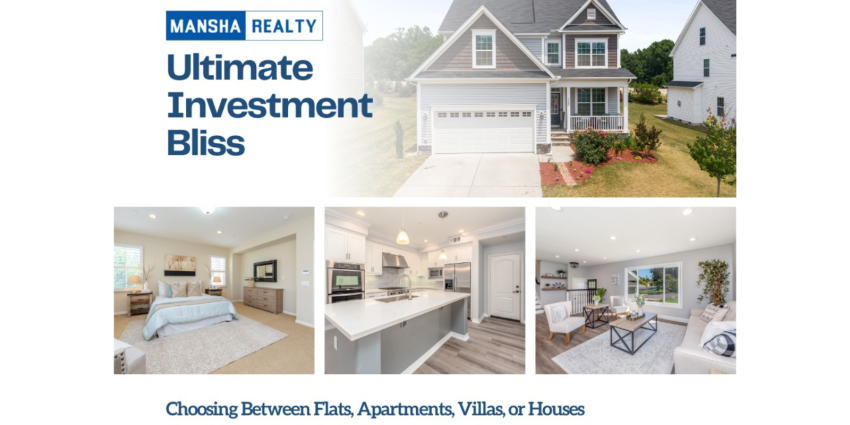In the labyrinth of real estate options, choosing the right property for investment can be a daunting task. The market presents an array of choices, each with its unique charm and potential returns. This write up aims to dissect the pros and cons of different property types – flats, apartments, villas, and houses – to guide prospective investors toward informed decisions.
Understanding Your Investment Goals:
Before delving into the specifics of property types, it’s crucial to define your investment goals. Are you looking for long-term appreciation, rental income, or a blend of both? Understanding your objectives will serve as a compass in the vast real estate landscape.
Flats:
Advantages:
- Affordability and Accessibility: Flats often boast a more affordable entry point into the property market, making them accessible to a broader range of investors. They are typically situated in urban areas, ensuring proximity to essential services and amenities.
- Low Maintenance: With shared maintenance responsibilities and often managed by homeowner associations, flats alleviate the burden of individual maintenance tasks. This can be particularly appealing for investors seeking a hands-off approach.
Considerations:
- Limited Space: Flats may have limited square footage compared to other property types. This limitation can impact potential rental income and may not cater to larger families.
- Less Privacy: Living in close proximity to neighbors might compromise privacy. Investors should weigh the benefits of community living against the potential for noise and reduced seclusion.
Apartments:
Advantages:
- Community Facilities: Apartments often come with shared amenities such as gyms, swimming pools, and recreational spaces. These communal facilities enhance the living experience and can be attractive to tenants.
- Security: Many apartment complexes invest in robust security measures, providing residents with a sense of safety. This can be a significant factor for those considering long-term rental or resale potential.
Considerations:
- Association Rules and Fees: Living in an apartment complex means abiding by homeowner association rules and potentially paying associated fees. Investors should understand these terms and assess their impact on the overall investment.
- Limited Customization: Unlike standalone houses, apartments may offer limited customization options. Investors with a keen interest in personalizing their space should consider this factor.
Villas:
Advantages:
- Space and Independence: Villas offer ample space, both indoors and outdoors, providing a sense of independence and exclusivity. This makes them suitable for larger families or those desiring a private, spacious retreat.
- Customization: Villas often allow for more significant customization, enabling investors to tailor the property to their preferences. This can be a crucial factor for those seeking a unique living space.
Considerations:
- Higher Maintenance Costs: The larger size of villas often translates to higher maintenance costs. Investors should factor in ongoing expenses for landscaping, repairs, and general upkeep.
- Market Demand: The demand for villas may be specific to certain demographics. Investors should assess the market demand in their target location to ensure a steady flow of potential buyers or tenants.
Houses:
Advantages:
- Ownership and Land: Houses typically come with a larger parcel of land, offering the perks of homeownership and potential for further development. This can be appealing to investors with a long-term vision.
- Privacy and Freedom: Houses provide a high level of privacy and autonomy. The absence of shared walls and limited proximity to neighbors offers a more secluded living experience.
Considerations:
- Higher Initial Investment: Houses often come with a higher initial investment compared to flats or apartments. Investors should assess their financial capacity and long-term goals before committing to a standalone house.
- Maintenance Responsibilities: The autonomy of a house also means sole responsibility for maintenance. Investors should be prepared for the ongoing costs and time commitment associated with property upkeep.
Conclusion:
In the realm of property investment, there is no one-size-fits-all solution. The best choice between flats, apartments, villas, or houses depends on individual preferences, financial considerations, and investment goals. A well-informed decision requires a thorough understanding of the advantages and considerations associated with each property type. As you embark on this exciting journey, consider consulting with real estate experts and conducting thorough market research to navigate the complexities of the real estate landscape successfully.

